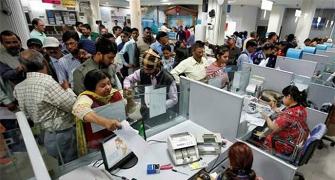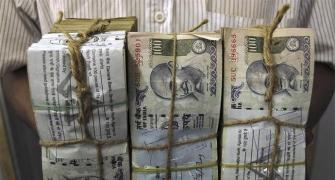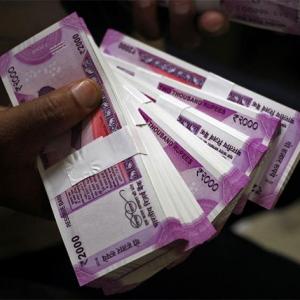Bad loans continue to originate mainly from state-owned banks, where the top management’s responsibility is not linked to career prospects nor has legal consequences, says Debashis Basu.

Just over a year ago in mid-May 2016 I had written a column pointing basic flaws in the new architecture set up to handle bad loans - a new huge bureaucracy (for insolvency), which only promised more legal complexities.
Well, it appears that I had not anticipated something far worse — continued ad-hoc and ham-handed tinkering of the bad loan problem by mandarins of the finance ministry and the Reserve Bank of India (RBI).
This has just attracted some sharp comments from the Gujarat High Court in the Essar Steel case.
In mid-June, the RBI wanted 12 select cases of bad loans be fast-tracked at the National Company Law Tribunal (NCLT).
Three weeks later, Essar Steel, one of the 12, went to the Gujarat High Court, arguing the RBI’s decision was selective, arbitrary and discriminatory; and it obtained a stay order.
During the two-hour hearing, Justice S G Shah reportedly expressed objection to the RBI’s stand that the NCLT was vested with the requisite powers to decide insolvency matters.
He remarked that parties were “free to approach the judiciary, which had complete jurisdiction to hear such matters also”.
According to a newspaper report, “questioning the NCLT’s insolvency powers whereby it appoints professional entities to manage insolvent companies, Shah jocularly commented that those with professional degrees may not necessarily be competent to run companies”.
Following this, in an extraordinary admission of bungling, the RBI admitted to the Court that it would issue a “corrigendum” to its notification. This episode has far-reaching consequences.
- The supposedly bold action of the finance ministry and the RBI of going after the dirty dozen has turned out to be hasty, ill-considered, clumsy and legally questionable.
- Every high court continues to have an open door to defaulters; the much-vaunted insolvency framework crafted by a bunch of legal luminaries and academics seems deeply flawed.
- It is only the first sign of how the new bad-loan resolution system will quickly get sucked into a legal quicksand. There will be pile up of cases and resolution will grind down to a snail’s pace, at least in case of larger accounts where speed is of essence.
Last year when the Insolvency & Bankruptcy Code (IBC) was passed, it was touted as one more step in making India an easier place to do business; India ranks particularly low on this score.
I had mentioned then that by getting this Act through, only a checkbox has been ticked; the new Act would unleash more of what has not worked so far - a deeper involvement of the state.
Bad loans continue to originate mainly from state-owned banks, where the top management’s responsibility is not linked to career prospects nor has legal consequences.
Hence, there is no solution in sight for continuing flow of bad loans; we are only talking of resolution of old bad loans (the stock).
Having created bad loans with one arm, the state then comes in to resolve them with another, through various means. Care to know how many efforts have been made over the past 30 years?
The Board for Industrial and Financial Reconstruction (1987), the Company Law Board (1991), the Recovery of Debts due to Banks and Financial Institutions Act (1993), and the Securitisation and Reconstruction of Financial Assets and Enforcement of Security Interest (Sarfaesi) Act passed (2002).
Over and above this, the so-called banking regulator has tried its hand (without any accountability) in Corporate Debt Restructuring (2001), Joint Lenders’ Forum (2014), what is called the 5/25 scheme (2014), Strategic Debt Restructuring (2015), and the Scheme for Sustainable Structuring of Stressed Assets (2016).
Nothing has worked. Getting the state involved again and using a new law as the main tool is simply insane; as also is, asking a committee of the RBI to direct NCLT to take up certain cases on priority.
I mentioned last year that the new system will soon become a cesspit of seedy deal-making, long inaction, stymied resolutions and tens of thousands of unresolved cases. We seem to have started off on this short journey already.
What is the solution? A simpler, more effective and cheaper system of resolving the big bad loans.
It exists in a market-driven approach, which most successful and economically advanced countries follow. It neither demands anything from the overburdened justice system, nor depends on the goodness of human hearts to do the right thing.
All we need is a market for distressed securities and high-yield bonds.
This will solve multiple issues at one stroke: Leave the resolution to incentivised buyers and sellers, not lawyers and professionals; allow more and more credit paper to be rated by rating agencies; establish an automatic and fairer value and price of stressed assets; invite billions of dollars from the likes of Oaktree Capital, JC Flowers, Goldman Sachs and KKR; and finally but most importantly, edge out incompetent promoters painlessly and quickly.
The collateral benefits are a much lower cost and faster resolution of the bulk of bad loans and more liquidity with banks.
Why haven’t we pursued this so far? Deep vested interests of academics, lawyers, bankers and accountants, who would like to feed off a clogged system as long as possible.
Photograph: Adnan Abidi/Reuters
Debashis Basu is the editor of www.moneylife.in.










